|
Harv
|
 |
« Reply #140 on: April 04, 2014, 10:54:01 PM » |
0
|
This is getting out of hand. I turn my back for 5 seconds, and another Norman finds it’s way into the house. This one is another of the later (Mike) Normans, 12” casing. Fitted to the top is a set of Hilborn injection. 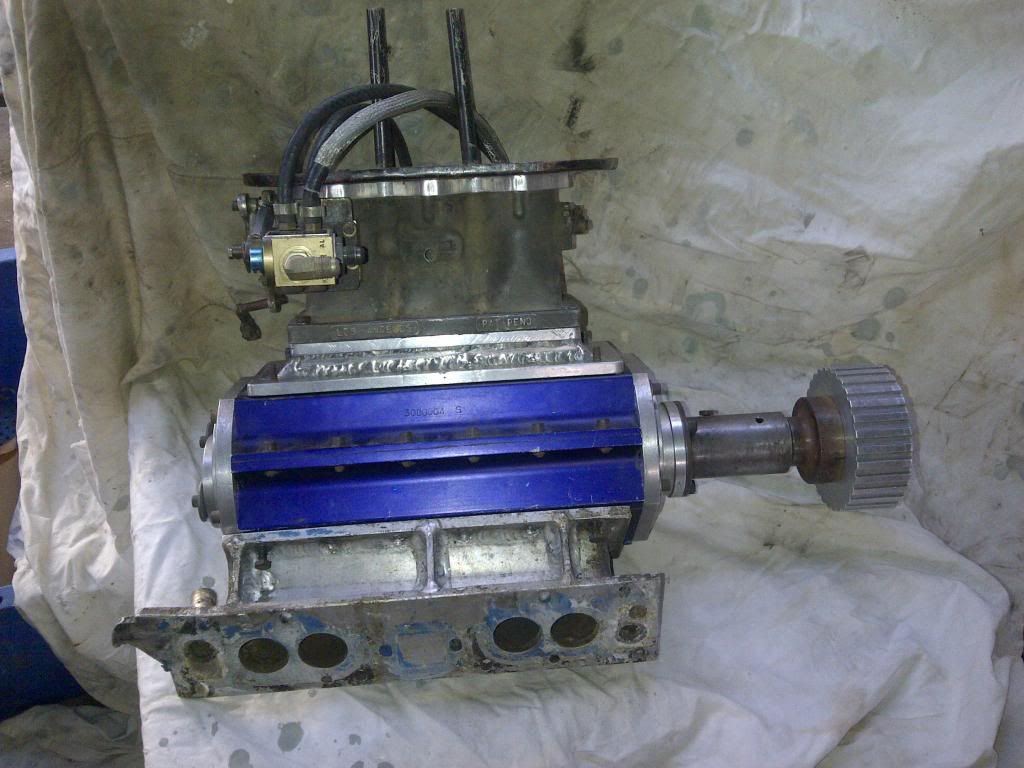 Hilborn injector is a model U-3, serial number 106. Three 2” throttle plates. The injector was originally purchased from Hilborn in the US on the 25th of July 1972 by R Brown from Glenanga South Australia (probably a Rowley Park Speedway competitor... if anyone knows of Mr Brown, I’d love to hear from them – already chasing the historic speedway guys). The original fuel pump was a PG150A-0, similar to the one currently on the unit set up for counter clockwise rotation with methanol fuel. The original metering valve was a #54, as existing. The injector was installed on a Peugot 403 engine of 1550cc (70ci) using a F500A fuel filter with Size #8 fittings. A secondary bypass of Hilborn #5 (F510-5) using a bypass spring 0.016 diameter, flow .66, jet 115. The unit was origanlly fitted to a Peugot 403 engine. This is a 1,468 cc (80mm bore and 73m stroke = 90ci) straight four with a crossflow hemi head. The engine produced 65 hp (48 kW) at about 5,000 rpm and 75 lb•ft (102 N•m) of torque at 2,500 rpm. To get 1550cc would mean going 90 thou over, which would be unusual (these are wet lined rather than bored so more likely to replace liner). Unlikely to be the 1618cc Peugot 404 engine (1960-75, 66-85bhp and 97 ft. lb. @ 2,500rpm) or 504 (1796cc) engine. If anyone knows Pug engines and wants to school me on how you get 1550cc from one, I’d love to hear it. Plan is to put this one in the longer term project department, then build a Norman blown grey motor meth monster :mrgreen: . Slowly putting the bits together. Cheers, Harv (Dr Frankenstein, Norman meth monster department). |
|
|
|
|
 Logged
Logged
|
|
|
|
FC427
nsw-club
Guru
    
 Offline Offline
Model: FC
Posts: 2457
I love YaBB 1G - SP1!

|
 |
« Reply #141 on: April 05, 2014, 09:37:42 PM » |
0
|
Harv have you ever spoken to Stan Pobjoy   he was a precision machinist for Hawker Dehailland he had the the old super charged VW powered drag bike that was 3rd fastest in the world back in 1972 he has a great wealth of knowledge he will be easy to track down as he is still doing the Dack Dack thing up at Coffs Harbour tell him you know little Gassy from Blacktown ......FC427..... |
|
|
|
|
 Logged
Logged
|
As I lay rubber down the street I pray for traction I can keep, but if I spin and begin to slide please dear god protect my ride
|
|
|
|
Harv
|
 |
« Reply #142 on: April 06, 2014, 06:35:40 AM » |
0
|
Cheers mate. I've heard of Stan, though never met him. I didn't realise he had worked at DeHavilland - they were doing some pretty cool stuff at one stage with metal spraying out at Bankstown. Nice to walk through a workshop with a parquetry floor  . Cheers, Harv |
|
|
|
|
 Logged
Logged
|
|
|
|
|
Harv
|
 |
« Reply #143 on: April 08, 2014, 07:11:56 AM » |
0
|
Ladies and gents, I’d like to back track a little to my recent posting on relief valves, and reflect a little bit on a discussion I have had recently with a gentlemen who owns a rather cool running Norman. This machine has had some damn clever engineering… the kind of stuff that makes you stop and think. An option that has been used on this particular vehicle is to utilize a radiator cap to act as a relief valve. This is a clever way to build a simple relief valve, as different pressure rating caps (eg 7, 10, 13 or 15psi) can be used to adjust the relief pressure. Radiator caps are readily available up to 30psi. A weld-on radiator neck from the local radiator repair shop can readily be brazed into a supercharger manifold. However, some caution needs to be taken when using this approach: Radiator caps have a large opening at the bottom, about the same size as the radiator filler neck. For most radiator caps, this hole is about the same size as the relief valve required. However, the radiator fluid (or in our case air/fuel mix) has to flow through the radiator inlet/outlet nipple, shown as the green arrow in the diagram below:  The inlet/outlet nipple is much smaller than the radiator neck, acting as a restriction. There is a good chance that this restriction can be too small, leading to overpressure. It may be necessary to braze in multiple inlet/outlet nipples to get sufficient surface area. Radiator caps are best known for keeping the pressure inside the radiator (or in our case the boost inside the inlet manifold). However, there are two types of radiator caps made – closed and recovery. If using a radiator cap for a relief valve, a closed cap must be used. Closed caps only open under pressure. A recovery radiator cap also acts as a vacuum breaker. The radiator cap not only has a pressure spring, but also a vacuum valve. When cold, both the pressure and vacuum valves of the cap remain closed. As the car warms up, the pressure in the cooling system rises. If the pressure begins to exceed the caps rated pressure, the pressure valve opens. As the engine load reduces, the pressure valve closes as the pressure comes down. As the vehicle cools down, any steam in the system will condense, and any hot air will shrink. This causes a vacuum in the radiator, and the vacuum valve opens. For older recovery radiator systems, air is drawn in through the vacuum valve to break the vacuum. For later cars with recovery coolant systems, coolant is drawn in from the overflow bottle. The vaccum required to open the vacuum valve will vary with manufacturer, though is very low. If we use a recovery-type radiator cap as a relief valve, the cap will again start out with both the pressure and vacuum valves of the cap closed. If we make too much boost pressure (or if we bang the blower), the pressure valve opens. However, under cruise conditions there is often a vacuum in the inlet manifold. The amount of vacuum will vary with different engines, but could be sufficient to allow the vacuum valve to open. If this occurs, the engine will draw in unfiltered air. The (potentially dirty) air will also bypass the carburetor, leading to a lean air/fuel mixture and the potential for pinging or engine damage. Additionally, there are two different types of recovery radiator cap produced (not to be confused with “closed” and “recovery” type caps). The first type is known as a "constant pressure" type cap, as shown in the top image below: |
|
|
|
|
 Logged
Logged
|
|
|
|
|
Harv
|
 |
« Reply #144 on: April 08, 2014, 07:12:58 AM » |
0
|
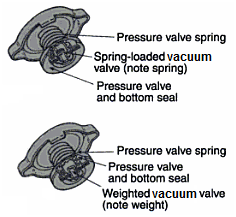 With this design, the vacuum valve is held shut by a very light spring, creating a totally sealed system. If this type of radiator cap is used on our supercharger, boost pressure will starts to rise immediately because the closed vacuum valve prevents pressure from escaping. The second type of cap has an open variety of vacuum valve (often called “pressure vent” caps), as shown in the bottom image above. This type has no spring to hold the vacuum valve shut, only a small calibrated weight. The intention with this type of cap is that when the engine is first started (and under light operating conditions), pressure can vent through the vacuum valve. This allows the cooling system to operate at atmospheric pressure, reducing strain on the water pump seals, hoses, radiator, and heater core. As the engine starts to heat up, the escaping steam or coolant pushes the vacuum valve up and shut. This seals the radiator system tight, and pressure begins to build in the radiator. As the engine load reduces, the pressure in the radiator drops, and the valve opens again. If we use this type of valve, we will start out with the pressure valve open. The engine will start with vacuum in the inlet manifold, drawing in unfiltered air. The (potentially dirty) air will again bypass the carburetor, leading to a lean air/fuel mixture and the potential for pinging or engine damage. As the engine loads up, the inlet manifold will change from vacuum to boost pressure. An air/fuel mixture will flow out the radiator cap and into the engine bay. This will happen every time the vehicle comes on and off boost. Whilst it is tolerable to vent a “banged blower” into the engine bay every now and then, it is not a great idea to frequently vent an air/fuel mixture into the engine bay. For this reason, “pressure vent” style caps should not be used as relief valves. Cheers, Harv (deputy apprentice Norman supercharger fiddler). |
|
|
|
|
 Logged
Logged
|
|
|
|
|
Harv
|
 |
« Reply #145 on: April 08, 2014, 11:56:33 AM » |
0
|
Ladies and Gents, As you guys have seen over the last few months, I have been trying to contact a number of people associated with Norman superchargers. There have been a few lumps and bumps along the way (the FED boys are proving hard to find :oops: ), but I've also had some real wins. I've managed to contact both Mike and Bill Norman  , and also Mike McInerney. Most of you can figure out where Mike and Bill fit into the picture, but I'm guessing not so many will be familiar with Mike McInerney. Time for the first of Harv's anecdotes :mrgreen: . I like stories. And I especially like stories about old racing cars. In the coming months I am going to post some stories about old Norman supercharged racing cars. The stories are going to be diverse, and don’t be surprised to see them going off on a tangent... bear with me, as the best stories are the ones that paint a picture of the era. I will also try to link some of these stories together where I can. Bear in mind that these anecdotes are a work in progress, and I probably won't get it right the first time... like always, if I'm wrong, point the error out please. Elfin, Bluebird and Norman – Australian Land Speed Records.Elfin Sports Cars Pty Ltd is the oldest continuous Australian racing car manufacturing company, founded by Garrie Cooper and manufacturing sports and racing cars since 1957. The original factory was located at Edwardstown in suburban Adelaide and is currently located at Braeside, Melbourne. Elfin is currently owned by Tom Walkinshaw, who also owns Holden Special Vehicles. Elfins have won 29 championships and major Grand Prix titles, including two Australian Driver's Championships, five Australian Sports Car Championships, four Australian Tourist Trophies and three Formula Ford titles. World Formula One Champion James Hunt raced an Elfin, as did French Formula One driver, Didier Pironi. Elfin also took out the Singapore Grand Prix, twice won the Malaysian Grand Prix and also won the Australian Formula Two Championship in 1972 with Larry Perkins in an Elfin 600B. Between 1961 and 1964 Elfin made twenty open-wheeled single-seater Formula Junior and Catalina vehicles. The two models differed only in minor specifications with the majority built as Formula Juniors. International Formula Junior class rule require production-based engines with a either 1000cc/360kg car or 1100cc/400kg car, using production gearbox cases and brakes. I understand that the Elfin Formula Juniors were originally fitted with Cosworth Ford Anglia (105E) 1100c engines, though the Catalinas were fitted with a larger 1475cc Ford engine to meet Australian class rules. Elfin Catalina Chassis Number 6313 was built for Dunlop Tyres for use on the Lake Eyre salt to determine certain characteristics for the tyres that were fitted to Donald Campbell's Bluebird land speed record attempts during 1963. The Elfin was fitted with 'miniature Bluebird tyres" and driven over the salt to determine factors such as co-efficient of friction and adhesion using a Tapley meter. The Tapley Brake Test Meter is a scientific instrument of very high accuracy, still used today. It consists of a finely balanced pendulum free to respond to any changes in speed or angle, working through a quadrant gear train to rotate a needle round a dial. The vehicle is then driven along a level road at about 20 miles per hour, and the brakes fully applied. When the vehicle has stopped the brake efficiency reading can be taken from the figure shown by the recording needle on the inner brake scale, whilst stopping distance readings are taken from the outer scale figures. It is believed that the Elfin was running a (relatively) normal pushrod 1500cc Cortina engine with A3 cam and Weber DCOE carburettors for the Bluebird support runs. The photo below was taken on Lake Eyre and shows Donald Campbell alongside the red Elfin holding aloft a wind speed meter, with the 3,320kW Bluebird-Proteus CN7 to the right. 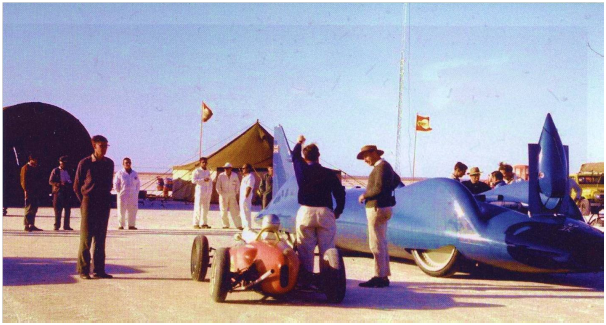 |
|
|
|
|
 Logged
Logged
|
|
|
|
|
Harv
|
 |
« Reply #146 on: April 08, 2014, 11:57:28 AM » |
0
|
The photo below shows Ted Townsend, a Dunlop tyre fitter seconded to the Bluebird team in the Elfin.  Bluebird went on to set the world land speed record at Lake Eyre at 403.10 mph (648.73 km/h) on July 17th 1964. Campbell has been quoted as saying “We've made it – we got the bastard at last”. Some nice history, but I guess you are wondering where the Normans are, right? When the Bluebird record attempts were completed, the Bluebird Tyre designer Mr Andrew Mustard (of North Brighton, Adelaide) bought the Elfin from Dunlop. The Elfin was in quite poor condition as a result of its work on the Lake Eyre Salt, with the magnesium based suspension struts quite corroded. A restoration took place over the end of 1963 and into 1964, and a single Norman supercharger fitted (see, told you this story had Normans :mrgreen: ). The vehicle was then used at Mallala Race Circuit, and for record attempts for 1500cc vehicles in 1964 using the access road alongside the main hangars at Edinburgh Airfield (Weapons Research Establishment) at Salisbury, South Australia. The northern gates of the airfield were opened by the Australian Federal Police to give extra stopping time. At this time the Norman supercharged Elfin had: • a single air-cooled Norman supercharger, driven by v-belts and developing around 14psi. The v-belts were short lived, burning out in around thirty seconds, • four exhaust stubs, with the middle two siamesed, • twin Amal carburettors, • a heavily modified head by Alexander Rowe (a Speedway legend and co-founder of the Ramsay-Rowe Special midget) running around 5:1 compression and a solid copper head gasket/decompression plate. The head had been worked within an inch of it’s life, and shone like a mirror. The head gasket on the other hand was a weak spot, lasting only twenty seconds before failing. As runs had to be performed back-to-back within an hour, the team became very good at removing the head, annealing the copper gasket with an oxy torch and buttoning it all up again... inside thirty minutes. The Norman supercharged Elfin, operated by Mustard and Michael McInerney set the following Australian national records from it’s Salisbury runs on October 11th, 1964: • the flying start kilometre record (16.21s, 138mph), • the flying start mile record (26.32s, 137mph), and • the standing start mile record (34.03s, 106mph). |
|
|
|
|
 Logged
Logged
|
|
|
|
|
Harv
|
 |
« Reply #147 on: April 08, 2014, 11:58:26 AM » |
0
|
The Australian national records are established (or broken) in conformity with the rules established by the Confederation of Australian Motorsport (CAMS). A national record is said to be a ‘class record’ if it is the best result obtained in one of the classes into which the types of cars eligible for the attempt are subdivided, or ‘absolute record’ if it is the best result, not taking the classes into account. The Norman supercharged Elfin falls into Category A Group I class 6. This class is based on the Fédération Internationale de l'Automobile (FIA) category system, and consists of automobiles (not necessarily production) with reciprocating two- or four-stroke supercharged engines of 1100-1500cc capacity, with free fuel. For the curious, our grey motored Norman blown early Holden is eligible for Category A Group I class 8 (2,000-3000cc). In 1983 CAMS made a decision to fully align the Australian national land speed records with the FIA requirements. The pre-1983 records were not fully compliant with all the FIA requirements, and hence have been set in stone – they can no longer be challenged. This means the Mustard/McInerney records above are still standing. However, the decision meant that all available records were declared vacant and able to be filled under the newly adopted FIA requirements for a speed record attempt. Two of the Mustard/McInerney type records have since been set as follows: • the flying start kilometre record (set by S Brooke in a Daihatsu Charade Turbo, 26.76s in 1985), and • the flying start mile record (again set by S Brooke’s Daihatsu Charade Turbo, 40.03s in 1985). The third Mustard/McInerney type record (for the standing start mile) does not have an Australian record holder. This is the case for many of the new (post 1983) classes, where no national records have been set (since 1983). Before you get too excited about going out and claiming all those records, there is a catch. A typical national record attempt is likely to cost between $5000 and $10,000... plus the vehicle costs. The photo below shows the Elfin in it’s 1964 guise at Salisbury, with McInerney in the foreground with his hands over the Amal carburettors. 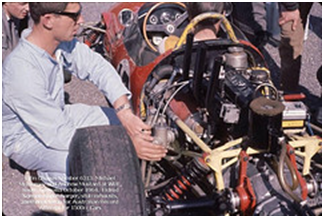 Directly below the four black exhaust stubs is what appears to be the red Norman supercharger, with an alloy end plate and brass welsh plug facing the camera. Note that in this state of tune the engine was able to be held together for only short periods (like nine minutes...) with only twenty seconds being typical with the car at full noise. The photo below shows McInerney (in glasses to the left) with Mustard in the cockpit. 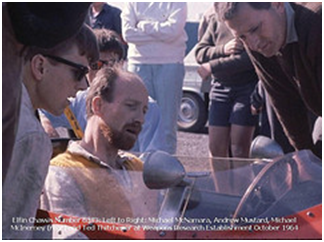 This was not the Elfin’s only association with Norman superchargers. The Elfin was later modified to have: • dual air-cooled Norman superchargers (identical to the single Norman used earlier), mounted over the gearbox. The superchargers were run in parallel, with a chain drive. The chain drive was driven by a sprocket on the crank, running up to a slave shaft that ran across to the back of the gearbox to drive the first supercharger, the down to drive the second. The boost pressure in this configuration had risen to 29psi, • two 2" SU carburettors (with four fuel bowls) jetted for methanol by Peter Dodd (another Australian Speedway legend and owner of Auto Carburettor Services), • a straight cut 1st gear in a VW gearbox. The clutch struggled to keep up with the torque being put out by the Norman blown Elfin, and was replaced with a 9” grinding disk, splined in the centre and fitted with brass buttons... it was either all in, or all out. In the twin Norman supercharged guise the vehicle was driven by McInerney to pursue the standing ¼ mile, standing 400m and flying kilometre records in October 1965. Sadly, the twin-Norman supercharged Elfin no longer holds those records, as the ¼ mile and flying kilometre (together with a few more records) were set at this time by Alex Smith in a Valano Special. The Valano Special is a Valiant 225 slant-six powered car with a fibreglass Milano body made by JWF Fibreglass. The pictures below show Smith in the Valano at Templestowe Hill Climb (once Australia’s steepest paved road at a gradient of 1:2½ or 22º) in Victoria, a year later in 1966. 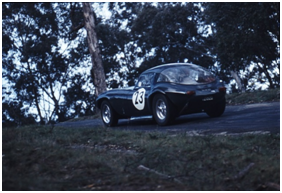 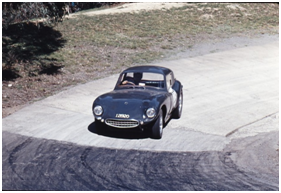 |
|
|
|
|
 Logged
Logged
|
|
|
|
|
Harv
|
 |
« Reply #148 on: April 08, 2014, 11:59:16 AM » |
0
|
The day following the 1965 speed record trials (Labour Day October 1965), McInerney raced the twin-Norman supercharged Elfincar at Mallala as a "Formule Libre" as there was insufficient time to revert the engine back to Formula II specifications. The photo below shows the McInerney in the Elfin at Mallala Race Circuit: 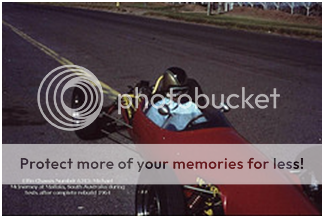 The car was used for training the South Australian Police Force driving instructors in advanced handling techniques, and regularly used at Mallala and other venues (closed meetings for the Austin 7 club, etc). It was sold by Mustard to Dean Rainsford of South Australia in 1966, though sadly without the Norman supercharger (by then it was running the mildly tuned Cortina engine again). The vehicle continued adding to it’s racing history, with Rainsford droving it to a win in the 1966 Australian 1½ Litre Championship Round 4 (the Victorian Trophy, Sandown, Victoria on the 16th of October 1966). In the ensuing twentysix years it passed through nine more owners before Rainsford re-acquired it in 1993. After many years of fossicking, Rainsford has located the original Mustard/McInerney supercharged engine used in the 1965 record attempts. The engine is located in Gawler, South Australia (not far from the record track at Salisbury) ... sadly without it’s Norman supercharger – see photo below. 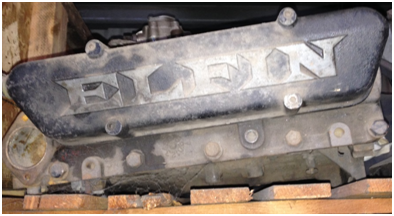 As noted above, this anecdotes is a work in progress. I'm still working on feedback from the Elfin Heritage Centre, and some other info coming on the Bluebird runs. As a tease, I'm lining up anecdotes on a Norman blown speedcar, and some FEDs :mrgreen: . Cheers, Harv (deputy apprentice Norman supercharger anecdote collector). |
|
|
|
|
 Logged
Logged
|
|
|
|
FC427
nsw-club
Guru
    
 Offline Offline
Model: FC
Posts: 2457
I love YaBB 1G - SP1!

|
 |
« Reply #149 on: April 10, 2014, 01:39:50 PM » |
0
|
Harv this is what you wanted you have a PM with Bateys Numbers .......FC427.........
Hi Mark
At great expense & hours of searching, I now have made contact with Chris Batey & he is expecting a phone call
|
|
|
|
|
 Logged
Logged
|
As I lay rubber down the street I pray for traction I can keep, but if I spin and begin to slide please dear god protect my ride
|
|
|
|
Harv
|
 |
« Reply #150 on: April 10, 2014, 03:51:51 PM » |
0
|
Thanks mate - very much appreciated. I'll give Batey a call tomorrow.
Have had a big week of phonecalls this week hunting down Norman-blown speedcars. There are still some incredible owners, builders and drivers out there.
Cheers,
Harv
|
|
|
|
|
 Logged
Logged
|
|
|
|
FC427
nsw-club
Guru
    
 Offline Offline
Model: FC
Posts: 2457
I love YaBB 1G - SP1!

|
 |
« Reply #151 on: April 10, 2014, 04:59:36 PM » |
0
|
|
|
|
|
|
 Logged
Logged
|
As I lay rubber down the street I pray for traction I can keep, but if I spin and begin to slide please dear god protect my ride
|
|
|
|
Harv
|
 |
« Reply #152 on: April 11, 2014, 08:57:25 AM » |
0
|
Getting closer  . I started out with Gary's Type 65, and just about have it at the point where I am happy with the supercharger itself. It's taking time, as I am working through each of the issues as I strike them. Next step is to sort out the 2" SU carb (will buy the kit and try to get the time to do the carb this month) and make up the carb-to-blower manifold (got most of it). Following that, it's time for pulleys (aiming to make a few quiet wrecker visits this month), then time to get serious with the inlet manifold. I've got one to use as a template, but need to check against the pulley choice. The bad thing is that I get distracted (that meth monster Norman is a good example), am on the road for work routinely, and still have a few other projects on the boil (the V8 wagon, sadly, I've owned for over a decade). Cheers, Harv |
|
|
|
|
 Logged
Logged
|
|
|
|
|
Ole
|
 |
« Reply #153 on: April 16, 2014, 07:41:54 PM » |
0
|
Hi Harv, for your info there is an article in the May edition of Street Machine about Eldred Norman and his exploits. I thought you may be interested.
Cheers Ole.
|
|
|
|
|
 Logged
Logged
|
Adelaide SA
|
|
|
|
Norm671
|
 |
« Reply #154 on: April 16, 2014, 08:41:13 PM » |
0
|
 Here is a front engine dragster we ran in the 90s equipped with a norman supercharger running a best et of 9.14 Cheers Norm McCormack |
|
|
|
|
 Logged
Logged
|
|
|
|
FC427
nsw-club
Guru
    
 Offline Offline
Model: FC
Posts: 2457
I love YaBB 1G - SP1!

|
 |
« Reply #155 on: April 16, 2014, 09:46:29 PM » |
0
|
Great shot Norm is that the rail Borg runs now ?   .......FC427...... |
|
|
|
|
 Logged
Logged
|
As I lay rubber down the street I pray for traction I can keep, but if I spin and begin to slide please dear god protect my ride
|
|
|
|
Norm671
|
 |
« Reply #156 on: April 16, 2014, 09:59:04 PM » |
0
|
No mate he has his own car, that was our old car , we are currently running in supercharged outlaws with a small
Chev still front engined best et 7.017 @ 194mph.
|
|
|
|
|
 Logged
Logged
|
|
|
|
|
Harv
|
 |
« Reply #157 on: April 17, 2014, 05:49:54 AM » |
0
|
Thanks Ole - appreciated. I need to get a copy of that mag... it also has a 3-page story on the Harrops Howler humpy. Not Norman related, but a cool piece of history. Looks like its a trip to the newsagent for me today  G'day Norm - great to see you on this thread. After our chat the other day I managed to get hold of Chris, and had a good chat about the Norman. I'm slowly piecing together four anecdotes: a) one on Norman superchargers and landspeed records, published above, b) one on Norman superchargers and speedway (midgets). This one is a work in progress, coming together nicely. c) one on Norman superchargers and FEDs. Have only just started on this story, and will probably need to chat to yourself and Chris some more. Have also found Ken's contact details, and will give him a yell. Sad that Cliff Kiss is no longer with us... that FED was very, very different  . d) one on Eldred himself. Sounds like Street Machine have beat me to that one... will have to se what they publish. Cheers, Harv (deputy Norman supercharger apprentice). |
|
|
|
|
 Logged
Logged
|
|
|
|
|
Harv
|
 |
« Reply #158 on: May 09, 2014, 06:21:55 PM » |
0
|
A couple of odds and ends for this post. One thing that has been bugging me is that people refer to the “Type 65” as having a capacity of 65ci. No matter how hard I did the measurements and maths, I could not get 65ci/rev. In re-reading Eldred’s Supercharge!, I found the answer. In earlier posts, I used a specific way to measuring supercharger capacity. The method I used (which is commonly used for modern superchargers) effectively says: a) Measure how much air the supercharger breathes in when the first set of vanes swings past the inlet. This air will be pretty much at atmospheric pressure, and b) Multiply that by the number of vanes. In the drawing below, this means work out the volume shown in red, and multiply it by six. 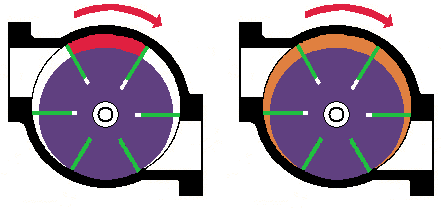 This gives the volumes shown in the table below (note that I have added a few new superchargers to this table since my earlier posting):  An alternate method was used by Eldred Norman (and is shown in Supercharge!): “To ascertain the volume of the vane type, subtract the volume of the rotor treated as a solid form from the volume of the interior of the casing”. This method says: a) Measure how much air is in the supercharger at any given time, no matter how compressed it is. In the drawing above, this means work out the volume shown in orange. Eldred’s method is neither more right nor more wrong than the modern method… just different. It also gives different results – a lot smaller number than the modern method. As an example, when we measure Gary’s Type 65 supercharger using the modern method, we get 118ci/rev. However, when we measure the Type 65 using Eldred’s method, we get 67ci/rev (near enough to 65ci, and hence the name). Also from earlier posts, I showed how to set the non-drive end clearance by changing the gasket thicknesses. I noted that both Repco and SuperCheap sell gasket sheet only as thin as 0.4mm (as thick as 3.2mm), whilst CBC Bearings stock 0.3mm (0.012”). To get thinner sheet, I was going to try Blackwoods, whose catalogues show both 0.15mm (0.006”) and 0.25mm (0.010”) as part numbers 05118683 and 05334302 respectively. Unfortunately, Blackwoods don’t stock the sheet anywhere in the country . They could get it in for me... but only if I bought 100 metres worth(!). I did a fair bit of telephoning around, and got the same answer at most places – yes they stock it, but order it in specially at 100m a time. I finally found a supplier - Tucks Industrial Packings and Seals Pty Ltd (120 Ferrars Street South Melbourne, Vic 3205, telephone 0396902577, email sales@tucks.com.au, http://www.tucks.com.au). Nice blokes to deal with, and very helpful. Cheers, Harv (deputy apprentice Norman supercharger fiddler). |
|
|
|
|
 Logged
Logged
|
|
|
|
|
Harv
|
 |
« Reply #159 on: May 19, 2014, 10:34:00 AM » |
0
|
Following on from my Norman supercharged landspeed record anecdote, the post below will share a similar story focussed on Speedway Normans. Norman superchargers were also used to some extent in Speedway racing in the 1960’s and 1970’s. This was particularly evident in South Australia, probably due to Eldred’s manufacturing operation being initially centred in Adelaide. From our earlier Norman supercharged land speed anecdote, remember that Andrew Mustard’s Norman supercharged Elfin cylinder head work was done by Alex Rowe. Alex Rowe was a close associate of Eldred Norman. In the mid 1950’s to early 1960s Alex Rowe had a workshop 9 Eliza Street St Peters, Adelaide. Rowe did a variety of work from this location, including manufacturing and selling floor shifters for early Holden grey motor crashboxes. Part of the workshop was offered to Eldred Norman to manufacture superchargers (Eldred had his workshop in Halifax street). Rowe and his wife Helen later ran the Golden Fleece Service Station in about 1967/1968 at 87 Winston Ave, Melrose Park (now the current Winston Avenue Music Shop), and lived nearby at 130 Morgan Avenue. Eldred’s larrikin nature was well demonstrated one Friday night when he popped around to visit Rowe’s Eliza Street workshop in the early 1950’s... in his supercharged road racing 1936 Maserati Type 6 CM. The South Australian Police were looking for a race car seen coming up King William Street from the Halifax street region... funnily the car ‘vanished’ around Franklin Street! Rowe began a long association with Norman superchargers by supercharging a £5 Ford Consul three-bearing crank engine in a midget in 1964. Midgets, also known as speedcars in Australia are methanol burning wingless Speedway (dirt track) vehicles. Modern midgets weigh in around 408kg with a 2721cc engine capacity (a little bigger at 3,000cc for standard engines, and a little smaller at 2,000cc supercharged) producing around 360bhp. Historic midgets were around 180-200bhp. Compare that to our trusty naturally-aspirated FB/EK Holden, coming in at 1100kg, with a 2300cc engine producing 75bhp... the historic midget’s that we will discuss below have a power to weight ratio seven times greater. Rowe’s Ford Consul engine was probably the 1508cc 47bhp engine from the 1951-1956 MKI Consul (rather than the 1703cc, 59bhp 1956-1962 MKII Consul) as the Speedway capacity regulations were for around 2200cc unsupercharged and overhead valved, with 1600cc supercharged. The Norman-blown Consul motored vehicle was the first of the famous yellow SA#2 Speedway midgets, driven for Rowe by Bill Wigzell and is shown in the image below with Wigzell chasing Rex Sandy’s #56 midget in 1966 at the 392-yard Rowley Park Speedway, South Australia. 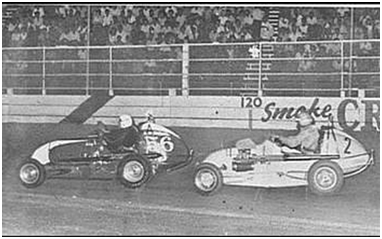 The article below describes one of Wigzell’s near-wins towards the end of the Consul-motor’s life in the vehicle. 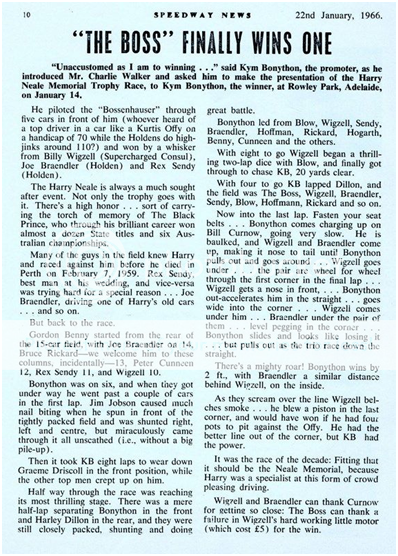 |
|
|
|
|
 Logged
Logged
|
|
|
|
|



